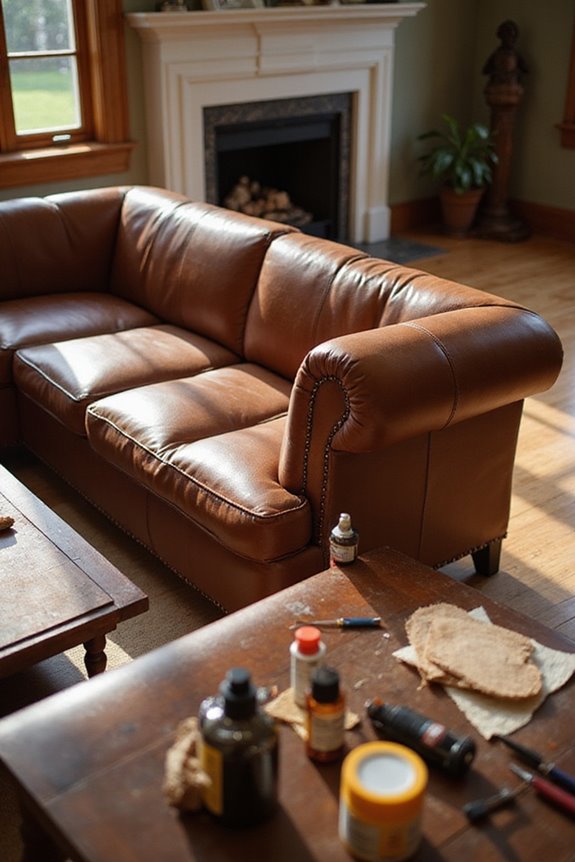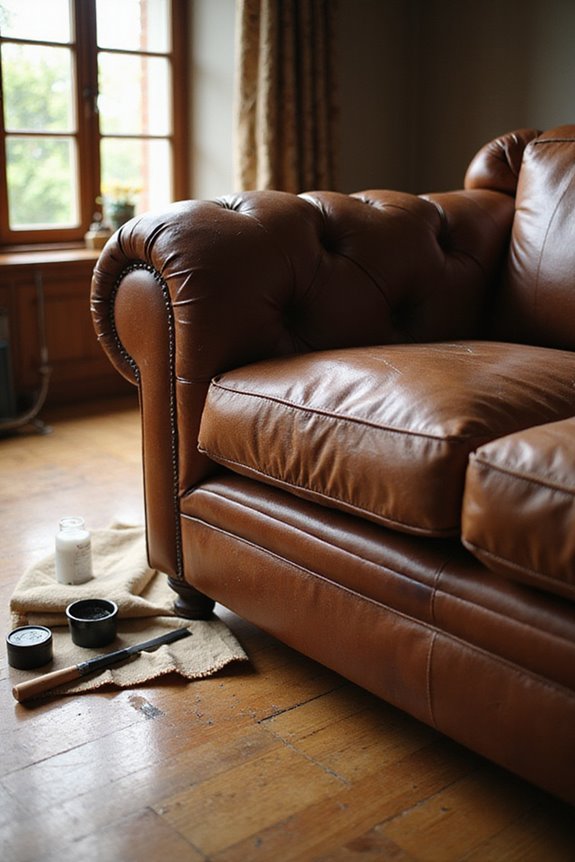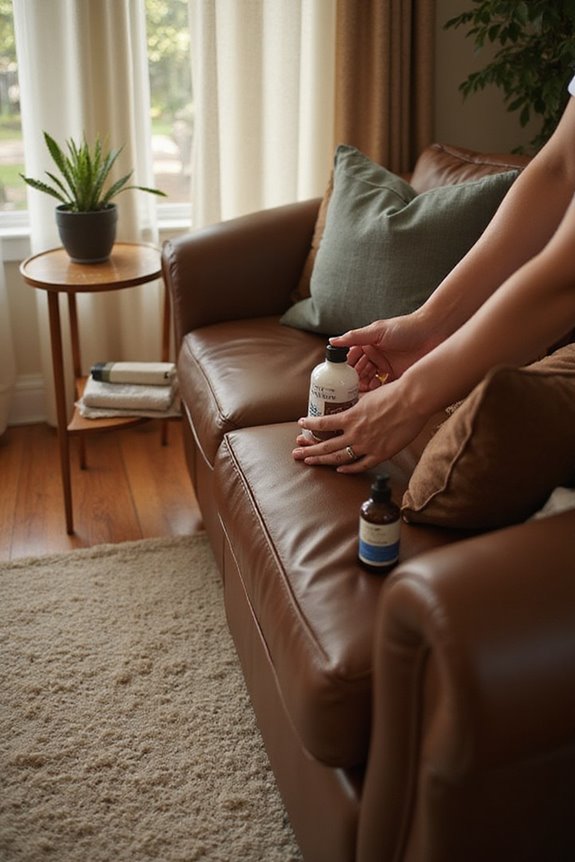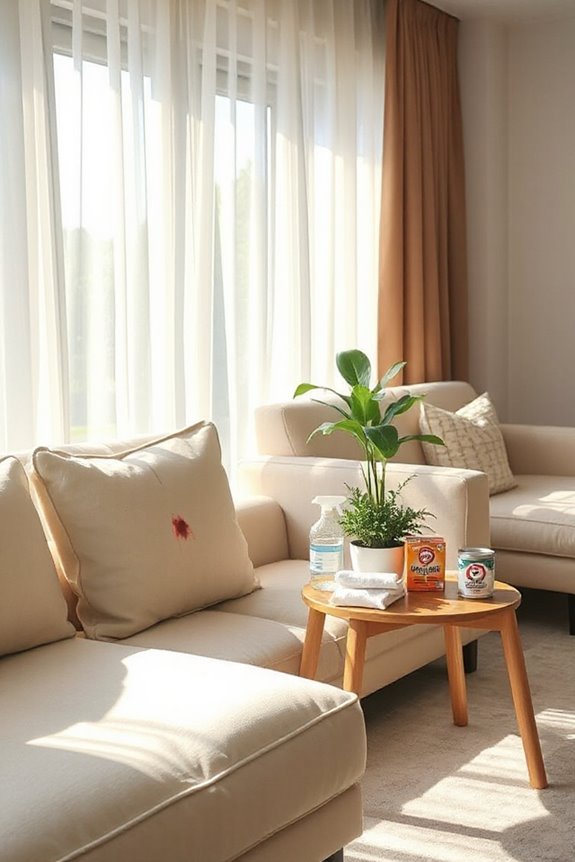If you’re looking to repair leather furniture, start by cleaning the surface gently with a pH-balanced cleaner. Got minor scratches? Just rub them with your fingers or add a bit of Vaseline! For tears, denim patches or leather filler work wonders. Don’t forget to seal your repairs! Curious about keeping your furniture looking fabulous? Regular dusting and conditioning every six months will help! Stick around, and you’ll uncover more great tips and tricks for leather care!
Key Takeaways
- Identify the leather type and use pH-balanced cleaners for routine cleaning and maintenance.
- For minor scratches, gently rub with fingers or cloth, apply Vaseline, and use heat to blend.
- Repair tears with denim or leather patches and secure them with glue; use leather filler for holes.
- Utilize the damp sponge method for grain texture and match dye colors for seamless repairs.
- Regularly dust and condition leather to maintain flexibility, and address spills promptly to prevent damage.
Cleaning and Preparation for Repair

When it comes to cleaning and preparing your leather furniture for repair, you might wonder where to start! First, identify your leather type—this helps you choose the right cleaning agents. Did you know that pH-balanced cleaners are key? You definitely want to avoid harsh chemicals like bleach or ammonia, as they can wreak havoc on your leather’s finish.
For routine cleaning, a mild dish soap diluted in distilled water works wonders. Use a soft, damp microfiber cloth to wipe gently. Remember, you shouldn’t scrub vigorously; just think of it as a nice spa day for your leather! Also, don’t forget to dust regularly to keep it looking sharp! How often do you clean? Aim for biannual cleaning for that fresh, comfy vibe. Additionally, regular cleaning and conditioning can extend the lifespan of your vintage leather sofa, ensuring it remains beautiful for years to come.
Repairing Minor Scratches

Scratches on leather furniture can be frustrating, but don’t worry—there are plenty of ways to tackle those pesky marks! First, try rubbing the scratch with your finger or a soft cloth. It’s amazing what a little friction can do! For those light scratches, apply Vaseline and let it sit; it really helps minimize their appearance. Ever thought of using a hairdryer? Yes! A gentle heat application from at least six inches away can lighten scratches, too.
Don’t forget leather conditioner. When you massage it in circular motions, it helps blend the scratch away! Additionally, consider using quality materials that offer durability and comfort to ensure your furniture lasts longer. Finally, keeping pets and sharp objects away from your leather can save you future headaches. So, will you give these scratch removal techniques a try?
Repairing Tears and Holes

After tackling those pesky scratches, you might find yourself facing a more challenging problem—tears and holes in your leather furniture. First, do a tear assessment to see how serious the damage is. For minor tears, you can use denim or leather patches for a solid fix. Cut a patch slightly larger than the tear and secure it with leather glue. Isn’t it great how a little patch can work wonders?
For holes, grab some leather filler putty. Apply it carefully, then sand it down once it dries. A smooth finish makes all the difference—trust me! Additionally, consider using a vintage velvet pillow as a stylish accent to complement your repaired leather furniture. Finally, don’t forget to seal the area to keep it safe from future mishaps. Your leather deserves it! Ready to get started?
Texturing and Finishing Techniques

Though restoring leather furniture might seem challenging, mastering texturing and finishing techniques can really elevate your repair game! You can start with texturing techniques like the damp sponge method to create a grain effect—perfect for tiny nicks. Ever tried spray-on products? They’re fun but require careful application; you’ll want to watch the temperature and humidity.
When it comes to finishing products, color matching is key. Use the right dyes to guarantee your repair looks seamless. Don’t forget to apply sealants for protection! Smoothing and buffing afterward helps blend everything in, making it look professional. Who knew leather repair could be this rewarding and creative? Ready to give it a shot? Your furniture will thank you!
Preventative Maintenance for Leather Furniture

If you’ve worked on texturing and finishing techniques, you probably know how satisfying it is to see your leather furniture get a fresh look. To keep it that way, embrace routine maintenance! Regularly dust with a soft cloth to prevent dirt buildup—easy, right? Plus, vacuum those tricky crevices.
Every 6–12 months, condition your leather with a specialized product to maintain flexibility—trust me, it’s worth it! And don’t forget to manage your environment; maintaining that perfect humidity helps with leather preservation. Keep it away from direct sunlight to avoid fading.
Oh, and if a spill happens, clean it quickly! With these steps, you’ll keep your leather furniture looking great for years to come! Isn’t that fantastic?
Common Challenges in Leather Repair
When it comes to leather furniture, common challenges can sometimes feel like a real headache. Fading from sunlight can ruin your beautiful couch, right? You can tackle fading prevention with window treatments and regular conditioning. This way, you extend your leather’s lifespan!
Then there’s oil absorption—yep, those pesky body oils! If you don’t clean regularly, they can seep in and stain. Quick action on oil spills is essential; blot immediately to prevent lasting damage. And hey, using a protective coating can help keep those oils at bay. So, remember to stay ahead of these challenges. With a little care, your leather can look stunning for years to come! Why not give it the love it deserves?
Tools and Materials Needed for Repair
Now, let’s talk repair materials! You can’t go wrong with a leather repair compound to fill in holes. Got deep cracks? Don’t worry; just use heavy filler! And if you’ve got a tear, consider a piece of backed fabric. Mixing colorants/adhesives is a must for that perfect match! Ready to tackle your furniture? Let’s do this!
When to Seek Professional Help
You’ve armed yourself with the right tools and materials for your leather furniture repair, but how do you know when it’s time to call in the pros? Recognizing damage is key! If you see extensive wear or a need for material replacement, it’s a sign you might need help. Maybe the repair looks too complicated, or you’re facing structural issues, like broken frames.
Don’t hesitate to seek a professional evaluation if high-quality results are your goal. They have the expertise to restore your furniture’s beauty! Plus, they can offer tailored solutions or advice to prevent future damage—talk about a win-win! So, if you find yourself in over your head, just remember: professionals can save you time and guarantee lasting results!
Frequently Asked Questions
How Long Do Leather Repairs Typically Last?
Leather repairs typically last several years, depending on repair longevity factors like material quality, skill level, and maintenance. By ensuring proper care, you enhance leather durability, allowing your repairs to stand the test of time.
Can I Use Regular Glue for Leather Repairs?
You might think regular glue’s convenient, but it won’t work well for leather repairs. For proper leather bonding, use specialized repair adhesives instead. They guarantee strong, durable connections that protect your leather from damage and discoloration.
Is It Possible to Change the Color of My Leather Furniture?
Yes, you can change the color of your leather furniture. For color matching, consider dye application, which can provide a natural look. Just remember to prepare the surface properly for the best results.
How Can I Prevent Fading in Leather Furniture?
Did you know that 90% of leather fading occurs due to sunlight exposure? To prevent fading, prioritize leather maintenance by keeping furniture out of direct sunlight and applying UV protectants regularly.
Are There Special Care Instructions After a Repair?
After a repair, you should focus on post-repair maintenance. Regularly condition your leather, avoid direct sunlight, and clean gently to guarantee durability. With proper leather care, your furniture will stay beautiful and last longer.




